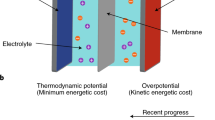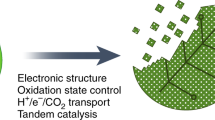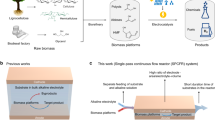Abstract
Biomass incorporates carbon captured from the atmosphere and can serve as a renewable feedstock for producing valuable chemicals and fuels. Here we look at how electrochemical approaches can impact biomass valorization, focusing on identifying chemical transformations that leverage renewable electricity and feedstocks to produce valorized products via electro-privileged transformations. First, we recommend that the field should explore widening the spectrum of platform chemicals derived from bio-feedstocks, thus offering pathways to molecules that have historically been derived from petroleum. Second, we identify opportunities in electrocatalytic production of energy-dense fuels from biomass that utilize water as the hydrogen source and renewable electricity as the driving force. Finally, we look at the potential in electrochemical depolymerization to preserve key functional groups in raw feedstocks that would otherwise be lost during harsh pre-treatments in traditional depolymerization routes. On the basis of these priorities, we suggest a roadmap for the integration of biomass and electrochemistry and offer milestones required to tap further into the potential of electrochemical biomass valorization.

This is a preview of subscription content, access via your institution
Access options
Access Nature and 54 other Nature Portfolio journals
Get Nature+, our best-value online-access subscription
$29.99 / 30 days
cancel any time
Subscribe to this journal
Receive 12 digital issues and online access to articles
$119.00 per year
only $9.92 per issue
Buy this article
- Purchase on Springer Link
- Instant access to full article PDF
Prices may be subject to local taxes which are calculated during checkout




Similar content being viewed by others
References
2016 Billion-Ton Report: Advancing Domestic Resources for a Thriving Bioeconomy. https://www.energy.gov/sites/prod/files/2016/12/f34/2016_billion_ton_report_12.2.16_0.pdf (US Department of Energy, 2016).
Lucas, F. W. S. et al. Electrochemical routes for the valorization of biomass-derived feedstocks: from chemistry to application. ACS Energy Lett. 6, 1205–1270 (2021).
Ng, K. S., Farooq, D. & Yang, A. Global biorenewable development strategies for sustainable aviation fuel production. Renew. Sustain. Energy Rev. 150, 111502 (2021).
Fargione, J., Hill, J., Tilman, D., Polasky, S. & Hawthorne, P. Land clearing and the biofuel carbon debt. Science 319, 1235–1238 (2008).
Vasilakou, K., Nimmegeers, P., Thomassen, G., Billen, P. & Van Passel, S. Assessing the future of second-generation bioethanol by 2030 – a techno-economic assessment integrating technology learning curves. Appl. Energy 344, 121263 (2023).
Lee, J., Xu, Y. & Huber, G. W. High-throughput screening of monometallic catalysts for aqueous-phase hydrogenation of biomass-derived oxygenates. Appl. Catal. B 140–141, 98–107 (2013).
Srifa, A., Faungnawakij, K., Itthibenchapong, V. & Assabumrungrat, S. Roles of monometallic catalysts in hydrodeoxygenation of palm oil to green diesel. Chem. Eng. J. 278, 249–258 (2015).
Zhang, C. et al. An investigation on the aqueous-phase hydrodeoxygenation of various methoxy-substituted lignin monomers on Pd/C and HZSM-5 catalysts. RSC Adv. 6, 104398–104406 (2016).
Yin, W. et al. Catalytic hydrotreatment of fast pyrolysis liquids in batch and continuous set-ups using a bimetallic Ni–Cu catalyst with a high metal content. Catal. Sci. Technol. 6, 5899–5915 (2016).
Weng, Y. et al. Aqueous-phase hydrodeoxygenation of biomass sugar alcohol into renewable alkanes over a carbon-supported ruthenium with phosphoric acid catalytic system. ChemCatChem 9, 774–781 (2017).
Sanna, A., Vispute, T. P. & Huber, G. W. Hydrodeoxygenation of the aqueous fraction of bio-oil with Ru/C and Pt/C catalysts. Appl. Catal. B 165, 446–456 (2015).
Lam, C. H. et al. Towards sustainable hydrocarbon fuels with biomass fast pyrolysis oil and electrocatalytic upgrading. Sustain. Energy Fuels 1, 258–266 (2017).
De Luna, P. et al. What would it take for renewably powered electrosynthesis to displace petrochemical processes? Science 364, eaav3506 (2019).
Seh, Z. W. et al. Combining theory and experiment in electrocatalysis: Insights into materials design. Science 355, eaad4998 (2017).
Meyer, T. H., Choi, I., Tian, C. & Ackermann, L. Powering the future: How can electrochemistry make a difference in organic synthesis? Chem 6, 2484–2496 (2020).
Tuck, C. O., Pérez, E., Horváth, I. T., Sheldon, R. A. & Poliakoff, M. Valorization of biomass: deriving more value from waste. Science 337, 695–699 (2012).
Yang, J. et al. CO2-mediated organocatalytic chlorine evolution under industrial conditions. Nature 617, 519–523 (2023).
Fauvarque, J. The chlorine industry. Pure Appl. Chem. 68, 1713–1720 (1996).
Chatenet, M. et al. Water electrolysis: from textbook knowledge to the latest scientific strategies and industrial developments. Chem. Soc. Rev. 51, 4583–4762 (2022).
Bozell, J. J. & Petersen, G. R. Technology development for the production of biobased products from biorefinery carbohydrates—the US Department of Energy’s ‘top 10’ revisited. Green. Chem. 12, 539–554 (2010).
Zhou, H., Li, Z., Ma, L. & Duan, H. Electrocatalytic oxidative upgrading of biomass platform chemicals: from the aspect of reaction mechanism. Chem. Commun. 58, 897–907 (2022).
Rahimpour, M. R., Jafari, M. & Iranshahi, D. Progress in catalytic naphtha reforming process: a review. Appl. Energy 109, 79–93 (2013).
Goetz, M. K., Bender, M. T. & Choi, K.-S. Predictive control of selective secondary alcohol oxidation of glycerol on NiOOH. Nat. Commun. 13, 5848 (2022).
Bender, M. T. & Choi, K.-S. Electrochemical oxidation of hmf via hydrogen atom transfer and hydride transfer on NiOOH and the impact of NiOOH composition. ChemSusChem 15, e202200675 (2022).
Goetz, M. K., Usman, E. & Choi, K.-S. Understanding and suppressing C–C cleavage during glycerol oxidation for C3 chemical production. ACS Catal. 13, 15758–15769 (2023).
Akhade, S. A. et al. Electrocatalytic hydrogenation of biomass-derived organics: a review. Chem. Rev. 120, 11370–11419 (2020).
Yang, M., Yuan, Z., Peng, R., Wang, S. & Zou, Y. Recent progress on electrocatalytic valorization of biomass-derived organics. Energy Environ. Mater. 5, 1117–1138 (2022).
Dodekatos, G., Schünemann, S. & Tüysüz, H. Recent advances in thermo-, photo-, and electrocatalytic glycerol oxidation. ACS Catal. 8, 6301–6333 (2018).
Li, T. & Harrington, D. A. An overview of glycerol electrooxidation mechanisms on Pt, Pd and Au. ChemSusChem 14, 1472–1495 (2021).
Taitt, B. J., Nam, D.-H. & Choi, K.-S. A comparative study of nickel, cobalt, and iron oxyhydroxide anodes for the electrochemical oxidation of 5-hydroxymethylfurfural to 2,5-furandicarboxylic acid. ACS Catal. 9, 660–670 (2019).
Roh, K. et al. Early-stage evaluation of emerging CO2 utilization technologies at low technology readiness levels. Green. Chem. 22, 3842–3859 (2020).
Kwon, Y., Schouten, K. J. P., van der Waal, J. C., de Jong, E. & Koper, M. T. M. Electrocatalytic conversion of furanic compounds. ACS Catal. 6, 6704–6717 (2016).
Li, K. & Sun, Y. Electrocatalytic upgrading of biomass-derived intermediate compounds to value-added products. Chem. Eur. J. 24, 18258–18270 (2018).
Banerjee, A., Dick, G. R., Yoshino, T. & Kanan, M. W. Carbon dioxide utilization via carbonate-promoted C–H carboxylation. Nature 531, 215–219 (2016).
Ramos, N. C., Manyé Ibáñez, M., Mittal, R., Janik, M. J. & Holewinski, A. Combining renewable electricity and renewable carbon: understanding reaction mechanisms of biomass-derived furanic compounds for design of catalytic nanomaterials. Acc. Chem. Res. 56, 2631–2641 (2023).
May, A. S. & Biddinger, E. J. Strategies to control electrochemical hydrogenation and hydrogenolysis of furfural and minimize undesired side reactions. ACS Catal. 10, 3212–3221 (2020).
Peng, T. et al. Ternary alloys enable efficient production of methoxylated chemicals via selective electrocatalytic hydrogenation of lignin monomers. J. Am. Chem. Soc. 143, 17226–17235 (2021).
Huber, G. W., Iborra, S. & Corma, A. Synthesis of transportation fuels from biomass: chemistry, catalysts, and engineering. Chem. Rev. 106, 4044–4098 (2006).
Wang, Y., Zou, S. & Cai, W.-B. Recent advances on electro-oxidation of ethanol on Pt- and Pd-based catalysts: from reaction mechanisms to catalytic materials. Catalysts 5, 1507–1534 (2015).
Posada, J. A. et al. Potential of bioethanol as a chemical building block for biorefineries: preliminary sustainability assessment of 12 bioethanol-based products. Bioresour. Technol. 135, 490–499 (2013).
Bender, M. T., Lam, Y. C., Hammes-Schiffer, S. & Choi, K.-S. Unraveling two pathways for electrochemical alcohol and aldehyde oxidation on NiOOH. J. Am. Chem. Soc. 142, 21538–21547 (2020).
Tian, C. et al. Paired electrosynthesis of H2 and acetic acid at A/cm2 current densities. ACS Energy Lett. 8, 4096–4103 (2023).
Zhou, Z. et al. Strain-induced in situ formation of NiOOH species on Co–Co bond for selective electrooxidation of 5-hydroxymethylfurfural and efficient hydrogen production. Appl. Catal. B 305, 121072 (2022).
Bender, M. T., Yuan, X., Goetz, M. K. & Choi, K.-S. Electrochemical hydrogenation, hydrogenolysis, and dehydrogenation for reductive and oxidative biomass upgrading using 5-hydroxymethylfurfural as a model system. ACS Catal. 12, 12349–12368 (2022).
Ge, R. et al. Selective electrooxidation of biomass-derived alcohols to aldehydes in a neutral medium: promoted water dissociation over a nickel-oxide-supported ruthenium single-atom catalyst. Angew. Chem. Int. Ed. 61, e202200211 (2022).
Kang, S., Fu, J. & Zhang, G. From lignocellulosic biomass to levulinic acid: a review on acid-catalyzed hydrolysis. Renew. Sustain. Energy Rev. 94, 340–362 (2018).
Lucas, F. W. S., Fishler, Y. & Holewinski, A. Tuning the selectivity of electrochemical levulinic acid reduction to 4-hydroxyvaleric acid: a monomer for biocompatible and biodegradable plastics. Green. Chem. 23, 9154–9164 (2021).
Andini, E., Bragger, J., Sadula, S. & Vlachos, D. G. Production of neo acids from biomass-derived monomers. Green. Chem. 25, 3493–3502 (2023).
Zhou, H. et al. Scalable electrosynthesis of commodity chemicals from biomass by suppressing non-faradaic transformations. Nat. Commun. 14, 5621 (2023).
Shahid, E. M. & Jamal, Y. Production of biodiesel: a technical review. Renew. Sustain. Energy Rev. 15, 4732–4745 (2011).
Liu, S. et al. Catalytic hydrodeoxygenation of high carbon furylmethanes to renewable jet-fuel ranged alkanes over a rhenium-modified iridium catalyst. ChemSusChem 10, 3225–3234 (2017).
Liu, S. et al. Molybdenum oxide-modified iridium catalysts for selective production of renewable oils for jet and diesel fuels and lubricants. ACS Catal. 9, 7679–7689 (2019).
Zhang, L. et al. A review of thermal catalytic and electrochemical hydrogenation approaches for converting biomass-derived compounds to high-value chemicals and fuels. Fuel Process. Technol. 226, 107097 (2022).
Sanyal, U. et al. Structure sensitivity in hydrogenation reactions on Pt/C in aqueous-phase. ChemCatChem 11, 575–582 (2019).
Singh, N. et al. Aqueous phase catalytic and electrocatalytic hydrogenation of phenol and benzaldehyde over platinum group metals. J. Catal. 382, 372–384 (2020).
Kwon, Y., Birdja, Y. Y., Raoufmoghaddam, S. & Koper, M. T. M. Electrocatalytic hydrogenation of 5-hydroxymethylfurfural in acidic solution. ChemSusChem 8, 1745–1751 (2015).
Singh, N. et al. Electrocatalytic hydrogenation of phenol over platinum and rhodium: unexpected temperature effects resolved. ACS Catal. 6, 7466–7470 (2016).
Carroll, K. J. et al. Electrocatalytic hydrogenation of oxygenates using earth-abundant transition-metal nanoparticles under mild conditions. ChemSusChem 9, 1904–1910 (2016).
Wang, Y., Xu, J., Pan, Y. & Wang, Y. Recent advances in electrochemical deoxygenation reactions of organic compounds. Org. Biomol. Chem. 21, 1121–1133 (2023).
Yuan, X., Lee, K., Bender, M. T., Schmidt, J. R. & Choi, K.-S. Mechanistic differences between electrochemical hydrogenation and hydrogenolysis of 5-hydroxymethylfurfural and their ph dependence. ChemSusChem 15, e202200952 (2022).
Ma, J., Wang, Z., Majima, T. & Zhao, G. Role of ni in ptni alloy for modulating the proton–electron transfer of electrocatalytic hydrogenation revealed by the in situ Raman–rotating disk electrode method. ACS Catal. 12, 14062–14071 (2022).
Tyburski, R., Liu, T., Glover, S. D. & Hammarström, L. Proton-coupled electron transfer guidelines, fair and square. J. Am. Chem. Soc. 143, 560–576 (2021).
Deng, W. et al. Evolution of aromatic structures during the low-temperature electrochemical upgrading of bio-oil. Energy Fuels 33, 11292–11301 (2019).
Chen, G. et al. Upgrading of bio-oil model compounds and bio-crude into biofuel by electrocatalysis: a review. ChemSusChem 14, 1037–1052 (2021).
Sanyal, U. et al. Hydrogen bonding enhances the electrochemical hydrogenation of benzaldehyde in the aqueous phase. Angew. Chem. Int. Ed. 60, 290–296 (2021).
Sanyal, U., Koh, K., Meyer, L. C., Karkamkar, A. & Gutiérrez, O. Y. Simultaneous electrocatalytic hydrogenation of aldehydes and phenol over carbon-supported metals. J. Appl. Electrochem. 51, 27–36 (2021).
Wang, G. et al. Electrocatalysis for CO2 conversion: from fundamentals to value-added products. Chem. Soc. Rev. 50, 4993–5061 (2021).
Awe, O. W., Zhao, Y., Nzihou, A., Minh, D. P. & Lyczko, N. A review of biogas utilisation, purification and upgrading technologies. Waste Biomass Valor. 8, 267–283 (2017).
Sun, Y., Zwolińska, E. & Chmielewski, A. G. Abatement technologies for high concentrations of NOx and SO2 removal from exhaust gases: a review. Crit. Rev. Environ. Sci. Technol. 46, 119–142 (2016).
Zakzeski, J., Bruijnincx, P. C. A., Jongerius, A. L. & Weckhuysen, B. M. The catalytic valorization of lignin for the production of renewable chemicals. Chem. Rev. 110, 3552–3599 (2010).
Li, C., Zhao, X., Wang, A., Huber, G. W. & Zhang, T. Catalytic transformation of lignin for the production of chemicals and fuels. Chem. Rev. 115, 11559–11624 (2015).
Zhang, C. & Wang, F. Catalytic lignin depolymerization to aromatic chemicals. Acc. Chem. Res. 53, 470–484 (2020).
de Gonzalo, G., Colpa, D. I., Habib, M. H. M. & Fraaije, M. W. Bacterial enzymes involved in lignin degradation. J. Biotechnol. 236, 110–119 (2016).
Akhtar, A., Krepl, V. & Ivanova, T. A combined overview of combustion, pyrolysis, and gasification of biomass. Energy Fuels 32, 7294–7318 (2018).
Sikarwar, V. S. et al. An overview of advances in biomass gasification. Energy Environ. Sci. 9, 2939–2977 (2016).
Garedew, M. et al. Electrochemical upgrading of depolymerized lignin: a review of model compound studies. Green. Chem. 23, 2868–2899 (2021).
Zhang, C. et al. Cleavage of the lignin β-o-4 ether bond via a dehydroxylation–hydrogenation strategy over a nimo sulfide catalyst. Green. Chem. 18, 6545–6555 (2016).
Ghahremani, R., Farales, F., Bateni, F. & Staser, J. A. Simultaneous hydrogen evolution and lignin depolymerization using nisn electrocatalysts in a biomass-depolarized electrolyzer. J. Electrochem. Soc. 167, 043502 (2020).
Stiefel, S., Lölsberg, J., Kipshagen, L., Möller-Gulland, R. & Wessling, M. Controlled depolymerization of lignin in an electrochemical membrane reactor. Electrochem. Commun. 61, 49–52 (2015).
Zhao, H. et al. Raw biomass electroreforming coupled to green hydrogen generation. Nat. Commun. 12, 2008 (2021).
Yang, C., Maldonado, S. & Stephenson, C. R. J. Electrocatalytic lignin oxidation. ACS Catal. 11, 10104–10114 (2021).
Acknowledgements
K.-S.C. acknowledges the financial support provided by the US Department of Energy (DOE), Office of Science, Office of Basic Energy Sciences, Catalysis Science Program under award DE-SC0020983. A.H. acknowledges the financial support provided by the US DOE, Office of Basic Energy Sciences, Catalysis Science Program under award DE-SC0023322. N.S. acknowledges US National Science Foundation grant 2320929. This work was authored in part by the Alliance for Sustainable Energy, LLC, the manager and operator of the National Renewable Energy Laboratory for the US DOE, under contract no. DE-AC36-08GO28308//SUB-2021-10692 Mod 1. This work was authored in part by the National Renewable Energy Laboratory, operated by Alliance for Sustainable Energy, LLC, for the US DOE under contract no. DE-AC36-08GO28308. Funding provided by the US Department of Energy Office of Energy Efficiency and Renewable Energy Bioenergy Technologies Office, in collaboration with the Chemical Catalysis for Bioenergy Consortium. The views expressed in the article do not necessarily represent the views of the DOE or the US Government. The US Government retains and the publisher, by accepting the article for publication, acknowledges that the US Government retains a nonexclusive, paid-up, irrevocable, worldwide license to publish or reproduce the published form of this work, or allow others to do so, for US Government purposes. This work was supported, in whole or in part, by the Bill and Melinda Gates Foundation (INV-061828).
Author information
Authors and Affiliations
Contributions
E.H.S. supervised the project. C.T., R.D., J.W. and E.H.S. co-wrote the paper. All authors discussed the ideas and assisted during the preparation of the paper.
Corresponding author
Ethics declarations
Competing interests
The authors declare no competing interests.
Peer review
Peer review information
Nature Catalysis thanks Haohong Duan and the other, anonymous, reviewer(s) for their contribution to the peer review of this work.
Additional information
Publisher’s note Springer Nature remains neutral with regard to jurisdictional claims in published maps and institutional affiliations.
Supplementary information
Supplementary Information
Supplementary Tables 1 and 2.
Rights and permissions
Springer Nature or its licensor (e.g. a society or other partner) holds exclusive rights to this article under a publishing agreement with the author(s) or other rightsholder(s); author self-archiving of the accepted manuscript version of this article is solely governed by the terms of such publishing agreement and applicable law.
About this article
Cite this article
Tian, C., Dorakhan, R., Wicks, J. et al. Progress and roadmap for electro-privileged transformations of bio-derived molecules. Nat Catal 7, 350–360 (2024). https://doi.org/10.1038/s41929-024-01131-6
Received:
Accepted:
Published:
Issue Date:
DOI: https://doi.org/10.1038/s41929-024-01131-6



